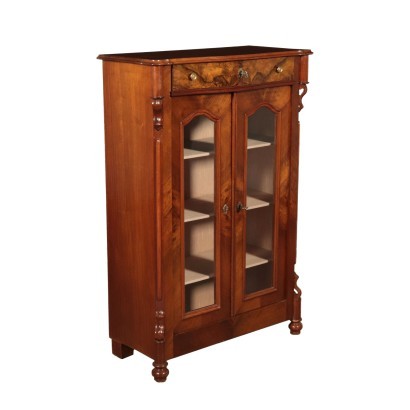Biedermeier Showcase, Walnut and Mahogany, Austria 19th Century
Features
Style: Biedermeier (1815-1848)
Age: 19th Century / 1801 - 1900
Origin: Austria
Main essence: Mahogany , Walnut
Description
Austrian Biedermeier showcase. Supported by four feet of which the frontal ones are lathered; pillars have scrolls inlaid on. Two frontal walnut veneered dooors with glass surmounted by a wavy walnut burl veneered drawer. Mahogany veneered top and sides. The showcase had been restored several times and is in fair conditions.
Product Condition:
Very good condition. Wear consistent with age and use. It may have been restored by an expert.
Dimensions (cm):
Height: 136
Width: 89
Depth: 41
Additional Information
Style: Biedermeier (1815-1848)
The Biedermeier style is a style that characterizes German and Austrian furniture between approximately 1815 (Congress of Vienna) and 1848 (beginning of the revolutionary movements).Its main features are essentiality and functionality, and the home destination.
Biedermeier first took on a derogatory connotation: the word derives from "Bieder", or "simpleton" and from "Meir", one of the most common German surnames at the time and was the name of a "simpleton" character in a comedy of Ludwig Eichrodt.
This term meant the conservative petty bourgeois, concerned only with his own family reality.
Even if in a derogatory way, the term represents exactly the new socio-political situation in which the bourgeois is forced or resigned to renounce the yearnings for democracy and freedom.
The center of life therefore becomes the home, no longer characterized by unbridled luxury but comfortable and practical.
Consequently, Biedermeier furniture are functional, comfortable and easily achievable products.
The style is an evolution of the Empire style towards greater simplification, without ornamental and antique elements, lighter, linear and curved shapes, lighter colors.
Find out more about the Biedermeier style with our insights:
Biedermeier, the comfortable and practical style
Biedermeier, when a style d 'furniture transforms an environment
FineArt: group eight Biedermeier applique, Vienna, 1820-1830
FineArt: Biedermeier Reifenluster, Vienna, c. 1820-1830 - Viennese chandelier




















